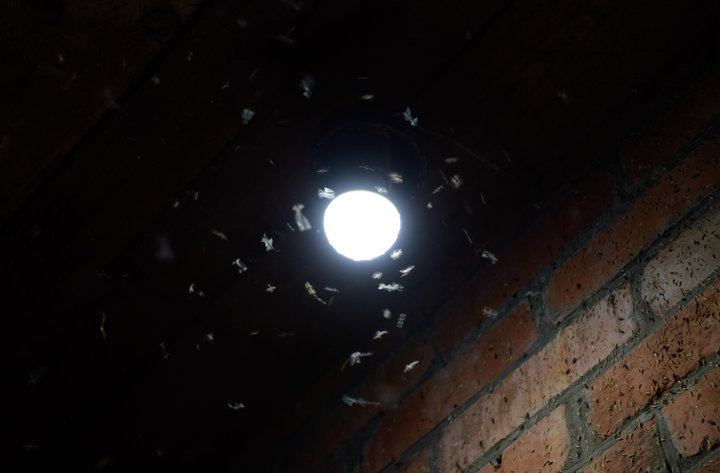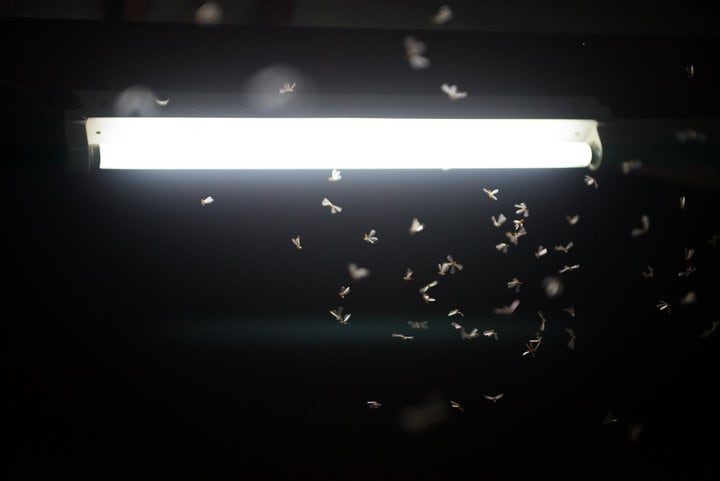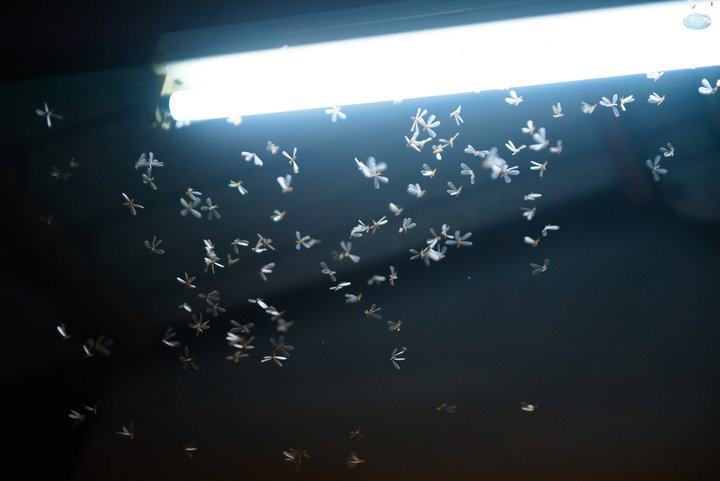The presence of insects in my home is an annoyance that really bothers me. I prefer an environment where none of these pests would be seen buzzing around.
You’ve probably noticed that insects tend to hover around lights, especially at night. Is that for a special reason, and does an LED light also attract bugs?
LED lights do attract bugs, but not as much as older bulb types that generate more heat. LEDs do emit UV light which has been found to attract insects more, but using a warmer-white or other warm colors can help minimise the attraction.
In this guide, I’ll explain:
- Why bugs love light
- The parts of the color spectrum that most attract bugs
Why Do Bugs Love Light?

There are different theories on why bugs love light – some may confuse lamps for the moon, and use it for directions, while others may confuse lights for flowers that reflect light. Heat from lights can also appeal to bugs.
Moon As Navigation
Nocturnal insects like moths use the moon or the stars as a navigational compass. Think of sailors in the past who used the North Star to determine where they should steer their boat to.
Insects have three unique eyes called ocelli to help them do this. These eyes have the specific job of identifying light instead of movement. Moths keep the moonlight at a constant angle as they move around in the world.
When these insects get too close to an artificial light source, they mistake the lamp for the moon.
Now, some lamps are omnidirectional light sources. These critters confusingly circle around the bulb to keep it at a constant angle, hence why they seem to be attracted to the light.
Floral Confusion
Some flowers reflect ultraviolet light. So when you have LED lights that produce UV light in small levels, that could appear to bugs that they are in fact flowers.
Bugs aren’t looking for petals or stems – they are looking for something that behaves like a flower does. That’s their intelligence level. So LED lights attract insects that are looking for a flower.
Are Insects Attracted To Light Or Heat?
Insects are attracted to both light and heat, depending on the species. Some insects gravitate towards lamps because of the light while others are attracted to warmth.
Like you and I, insects like to get warm and cozy.
So they gather around lamps as we do around a campfire. If you look closely enough, you might see them toasting tiny marshmallows as they share stories around the light.
On a more serious note, you might conclude that lamps that do not emit heat will attract fewer bugs. And you’d be right!
Traditional incandescent bulbs and other older light bulbs are more attractive to heat-seeking bugs. LED bulbs produce less heat so they’re a better choice if you want to keep the bug invasions to a minimum.
What Light Color Spectrum Attracts Bugs?

According to a scientific study, the colors of light that attract bugs from most to least are:
- Black (ultraviolet light)
- Blue
- White
- Yellow
- Green
- Red
The scientists found the ocelli are better at detecting short wavelengths of light, ie ultraviolet. They struggle to see warmer colors of light on the visible light spectrum.
Why Are Bugs Attracted To Blue Light?

Bluish lights are more attractive to bugs because light wavelengths in the blue-purple spectrum are easier for bugs to see.
Using cool lights (in terms of color, not actual heat temperature) is more likely to bring the insects to your home because the bugs can see the light better, and from further away.
That’s why insect light traps use lights on the blue spectrum to tempt bugs to their doom. That color also means the light’s UV output is higher.
Japanese scientists found that not only does blue light attracts bugs. They also cause death to some insects, such as fruit flies, mosquitoes and flour beetles.
Death by overexposure was what the scientists call it. The light damages the cells in their bodies. I guess you can best relate it to a sun-loving beach-goer getting sunburned. Awful comparison, I know.
Why Do Red LED Lights Attract Bugs Least?
Lights in the warmer part of the color spectrum, especially red lights, are harder for bugs to see. They also mimic daytime light more, and so can confuse bugs that rest during the day and then look for food at night.
No light color will actively repel bugs, but you can minimize the appeal of a light bulb by using warmer lights that are less visible.
You should know that yellow fluorescent lights are used in agricultural settings for effectively controlling insects’ behavior.
In the daytime, these insects rest near a food source. At night, they fly to a fruit orchard to suck on the juice of fruit and mate.
So, by using yellow light above a specific brightness, the nighttime behavior switch in the insects’ brains is never turned on!
This is employed in outdoor lighting but it’s true in the home as well – using yellow lights instead of blue-white light should attract fewer bugs.
Other tips for keeping bugs in your home to a minimum include:
- Cleaning gutters and drains to avoid mosquitoes from breeding
- Installing window screens to keep the critters out
- Hanging a bug zapper outdoors as the first line of defense
- Upgraded Bug Zapper with LED Light. The whole new mosquito zapper with a LED light, can enhance the...
- Electric Bug Zapper. This bug zapper for outside inside, use high-effective ultraviolet light to...
Last update on 2025-11-06 / Affiliate links / Images from Amazon Product Advertising API
Final Words
So there you have it. Use warm-color LEDs, and you’ll have significantly fewer insects in your home.
Make sure you don’t use incandescents because insects swarm to them, thanks to the heat.
I’ve also written guides on whether LED strips attract spiders, how to keep bugs away from outdoor lights, and whether yard lights deter larger critters, if you need more help with wildlife and lighting.
Looking for an LED bulb but not sure what type you need?
Check out my free bulb picker and select the right bulb within few clicks.

